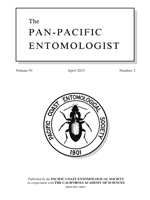The large ribosomal RNA subunit (16S rRNA) and cytochrome C subunit 3 (CO3) genes have been partially amplified and sequenced for the species of Chrysoperla Steinmann, 1964 (Neuroptera: Chrysopidae) inhabiting the western part of Saudi Arabia to examine their molecular variability. Insect samples were collected from three distant localities, which were Tabouk in the north, Jeddah in the middle and Jazan in the south of the country. The concatenated sequences (904 bp) have been manipulated by three analytical methods (maximum-parsimony, neighbor-joining and maximum-likelihood) producing one fixed tree. The tree topology divided, with strong statistical supports, Saudi Arabian Chrysoperla into two clusters. Jeddah and Tabouk samples clustered (BP = 100%) with both Chrysoperla carnea (Stephens, 1836) and Chrysoperla nipponensis (Okamoto, 1914), while Jazan samples grouped (BP = 100%) with Dichochrysa tacta (Navás, 1921). Both pairwise genetic distances obtained from the concatenated data and amino acid substitution in CO3 gene supported this division. It could be concluded that Saudi Arabian Chrysoperla constitutes a species complex and requires further molecular investigation.
BioOne.org will be down briefly for maintenance on 17 December 2024 between 18:00-22:00 Pacific Time US. We apologize for any inconvenience.
How to translate text using browser tools
14 July 2015
Molecular variability of Chrysoperla Steinmann, 1964 (Neuroptera: Chrysopidae) inhabiting western Saudi Arabia
Samy M. Sayed,
Sayed A. Amer
ACCESS THE FULL ARTICLE

The Pan-Pacific Entomologist
Vol. 91 • No. 2
April 2015
Vol. 91 • No. 2
April 2015
biodiversity
green lacewing
mitochondrial DNA




